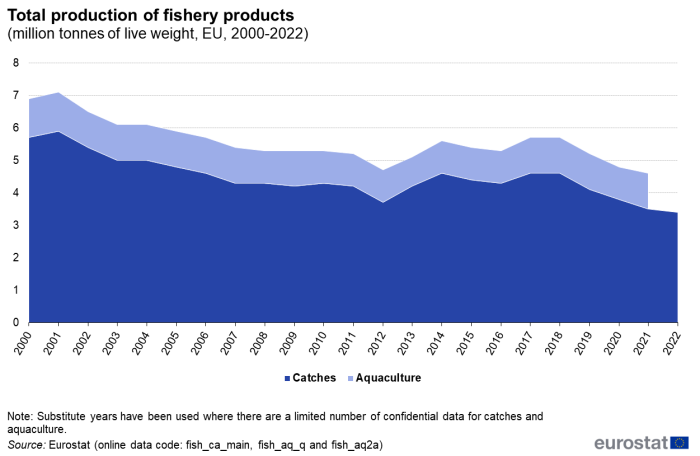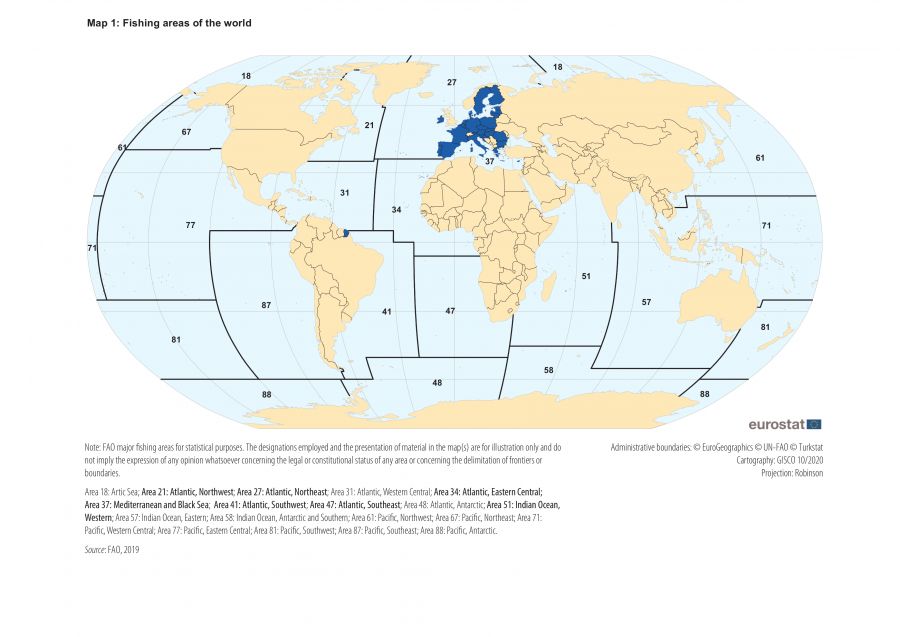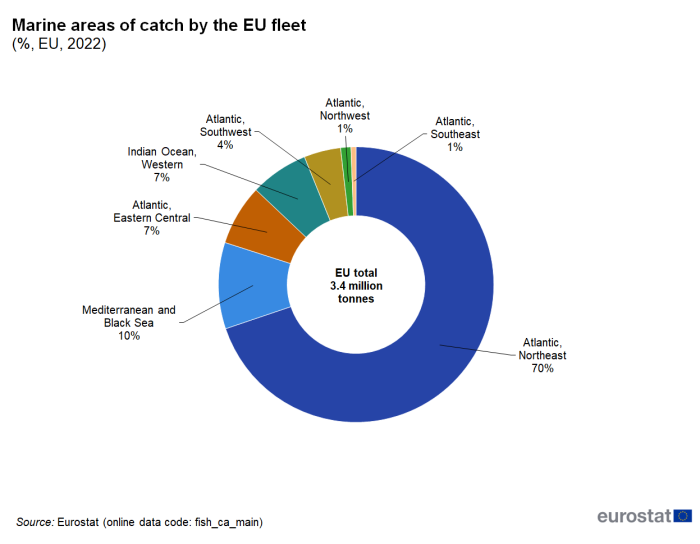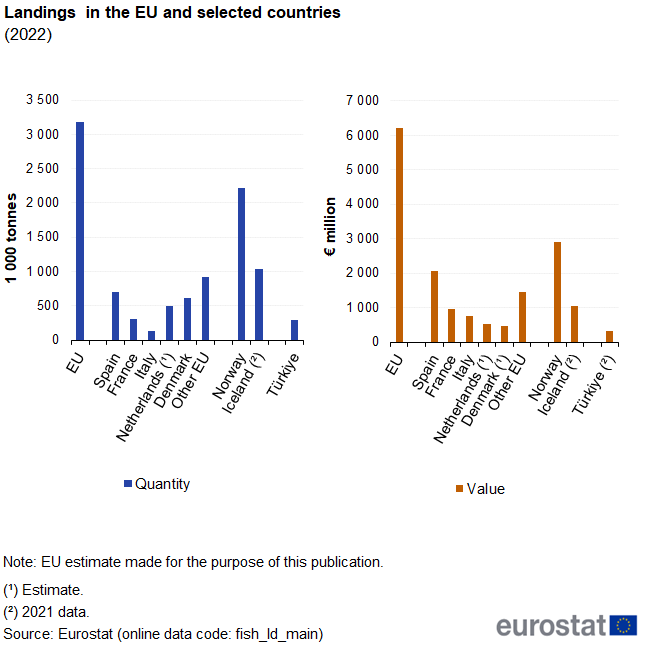Fisheries - catches and landings
Data extracted in November 2023.
Planned article update: November 2024.
Highlights

(million tonnes of live weight, EU, 2000-2022)
Source: Eurostat (fish_ca_main), (fish_aq_q) and (fish_aq2a)
This article gives an overview of recent statistics relating to fishing fleets, fish catches, and fish landings in the European Union (EU).
Fish are a renewable and mobile natural resource. Aside from aquaculture farming, fish are generally not owned until they have been caught. As such, fish stocks continue to be regarded as a common, wild resource which needs to be managed collectively. This has led to a range of policies that regulate the amount of fishing at the EU level and more widely at sea basin level, as well as the types of fishing techniques and gear that can be used in fish capture.
The current common fisheries policy (CFP) of the EU [1] aims at an environmentally, economically and socially sustainable use of the common resource including aquaculture production. The CFP is a set of rules for managing EU fishing fleets and for conserving fish stocks. Designed to manage a common resource, it gives all EU fishing fleets equal access to EU waters and fishing grounds and allows fishermen to compete fairly. The current policy stipulates that between 2015 and 2020 catch limits should be set that are sustainable and maintain fish stocks in the long term. Based on EU legislation, Eurostat produces statistics on catches and landings of fishery products, aquaculture and the EU fishing fleet.
Full article
Fisheries: the factors of production
The EU's fishing industry is managed; there is regulation on the amount of fishing at EU level and at sea basin level under the common fisheries policy (CFP). To better monitor and advise on this policy, there is interest in understanding the factors of production and how they are changing over time. These factors include the seas, fishing fleets and the labour force working in the fishing industry.
Seas and catch limits
EU statistical regulations on catching fish cover seven marine areas[2]; these are the north-east Atlantic; north-west Atlantic; Mediterranean and Black Sea; eastern-central Atlantic: south-east Atlantic; south-west Atlantic; and, western Indian Ocean, within each of which are a number of seas. For example, within the north-east Atlantic region are, among others, the Barents Sea, the Norwegian Sea, the Baltic Sea, the North Sea, Iceland and Faroes Grounds, Rockall, West of Scotland, the Irish Sea, the Bay of Biscay, Portuguese Waters, Azores Grounds and East Greenland.
As a general rule, fishing vessels registered in the EU fishing fleet register have equal access to all the EU waters and resources that are managed under the CFP. Access to fisheries is normally authorised through a fishing license. The seas resources for most commercial fish species are, however, limited through total allowable catches that are set annually for various sea regions based on the scientific advice provided by advisory bodies like the International Council for the Exploration of the Sea (ICES) and the Scientific, Technical and Economic Committee for Fisheries [3].
The proximity of a port to sea often determines the focus of fishing activities. For example, Denmark's fishing industry focuses on the north-east Atlantic area. One exception is Spain, for whom fishing activities are spread out across the different regions of the Atlantic and Indian Ocean for which EU data are collected, as well as other seas around the world. This spread of fishing grounds reflects the search for fish that have coldwater, coolwater or warmwater requirements.
The EU fishing fleet is getting smaller in number, capacity and power
Reducing the fleet capacity is an essential tool for achieving a sustainable exploitation of fisheries resources under the CFP. The EU fishing fleet has declined steadily since the early 1990's, in terms of both tonnage (an indicator of fish-holding capacity) and engine power (an indicator of the power available for fishing gear).
The EU fishing fleet continues to shrink. The number of active vessels in the EU was 72 595 in 2022. These vessels had a combined capacity of 1.3 million gross tonnes and a total engine power of 5.3 million kilowatts (kW). In the decade between 2013 and 2022, the number of vessels in the EU declined by an estimated 11 %, the overall gross tonnage fell by 9 % and engine power was down 9 %.
The EU fishing fleet is diverse; Spain has the highest gross tonnage, France most power and Greece most vessels
The EU fleet is very diverse, with the vast majority of boats being no more than 10 metres long, and a small number of vessels exceeding 40 metres in length. The average size of an EU fishing boat in 2022 was 18.5 gross tonnes and the average engine power was 73.4 kW.
When measured by gross tonnage, Spain had, by far, the largest fishing fleet among Member States (23.7 % of the EU total), followed by France (13.1 %) and Italy (10.9 %). However, when measured by engine power, the largest fleet was that in France (18.0 % of the EU total), followed by Italy (17.8 %) and Spain (14.2 %).
When measured by the number of vessels, the largest fleet in the EU was in Greece (17.8 % of all vessels), followed by Italy (16.9 %) and Spain (11.9 %). Greek vessels were generally small, with an average size of 5.0 gross tonnes, and an average engine power of 29.6 kW in 2022.

(% based on gross tonnage, 2022)
Source: (fish_fleet_alt)
By way of comparison, the overall holding capacity of the Norwegian fishing fleet was the largest in Europe (0.46 million tonnes in 2022, which was 21.5 % more than that in 2013). It was also considerably more powerful than the EU average, with an average 249.9 kW per vessel. The 1 540 fishing vessels of Iceland in 2022 were also much larger and more powerful than the EU average, with an average holding capacity of 105.8 gross tonnage per vessel and 294.0 kW per vessel.
The fisheries industry provided jobs in the EU for about 160 000 people in 2021
An estimated 160 000 people were employed in the EU's primary fisheries industry in 2021, of which about one third were employed in the aquaculture subsector. About one quarter of employment in the primary fisheries industry of the EU in 2021 was in Spain. Indeed, three quarters of EU employment in the industry was concentrated in just Spain, Italy, Greece, France and Portugal.
Italy, Greece and Portugal accounted for much higher proportions of employment in the EU fisheries industry than of fisheries production; together they accounted for about 37 % of EU employment in the industry, but only produced about 15 % of production. Conversely, Denmark and the Netherlands had relatively low employment in fisheries (1 % to 2 % respectively of the EU total) but much higher shares of fisheries production (about 11 % and 7 % respectively). These contrasts highlight the differences between the fishing industries of some countries with a relatively large number of small vessels and others with a relatively small number of large vessels.

(% share of EU totals, 2021)
Source: Eurostat (nama_10_a64_e), (fish_ca_main), (fish_aq_q) and (fish_aq2a)
Catches
The monitoring of catches is an essential tool for securing fish stocks and sustaining the common resources available in Europe's large and rich fishing areas.
EU catches in 2022 were an estimated 3.4 million tonnes of live weight, a continuation of the downward trend
Fish catches cover fish, molluscs, crustaceans and other aquatic animals, residues and aquatic plants that are taken for all purposes, by all types and class of vessel, gear and fishermen, operated in all the seven marine areas legally covered by EU statistical regulations. They cover catches in high-sea fishing areas, offshore, inshore or brackish water areas. The production from aquaculture and catches in fresh water are excluded.
The total EU catch in 2022 was an estimated 3.4 million tonnes live weight. This new low in catches was well beneath the estimated 4.6 million tonnes in 2017 and 2018 and much lower still than the 5.9 million tonnes caught in 2001 (see Figure 3).

(million tonnes of live weight, EU, 2000-2022)
Source: Eurostat (fish_ca_main), (fish_aq_q) and (fish_aq2a)
The fishing fleets of Spain, France, Denmark and the Netherlands accounted for a about half (about 50 %) of the total amount of aquatic organisms caught by Member States in 2022 (see Figure 4). Catch levels were further down in Denmark; the reduction in catches between 2021 and 2022 was 7 770 tonnes, the equivalent of a 1.7 % reduction and relatively unchanged level in Spain (+0.1 %). These developments were in contrast to the increase in France (+7.0 %, or +33 600 tonnes). Catch levels in 2022 were also lower than 2021 in many other Member States, not least Poland (down 26 600 tonnes), Sweden (down another 14 300 tonnes), Italy (down 12 800 tonnes), Lithuania (down 12 600 tonnes) and Finland (down another 8 900 tonnes). Apart from France, there were also notably higher catch levels in Greece (up 6 800 tonnes) and Germany (up 4 700 tonnes).
Spain and Portugal were the only Member States that took catches in all of the seven fishing areas covered by the EU catch statistics.

(1 000 tonnes live weight, 2022)
Source: Eurostat (fish_ca_main)
The vast majority of the EU catch is taken in the Atlantic, Northeast area
About 70 % of all EU catches in the seven marine areas covered by EU statistical regulations were taken in the Atlantic, Northeast area (see Figure 5 and Map 1 for an overview of fishing areas). The key species caught in the Atlantic, Northeast area in 2022 were herring (19 % of the live weight caught in this region), sprat (14 %), blue whiting (11 %) and mackerel (10 %).
About one fifth of the EU's total live-weight catch in the Atlantic, Northeast area was made by the fishing fleet of Denmark. Together, France (about 17 %), the Netherlands (11 %) and Spain (11 %) accounted for almost another one two fifths of catches in the region.
About one tenth of the total EU catch was taken in the Mediterranean and Black Sea, where the main species caught were sardines (22 % of the EU catch in the area) and anchovies (18 %). Two fifths of the total EU catch in this area was by the Italian fleet (36.3 %), with the fleets of Greece (18.8 ), Croatia (18.2 %) and Spain (17.7 %) together accounting for the vast majority of the rest.
About 7 % of the total EU catch was taken in the Atlantic, Eastern Central area, where the main catches were mackerel and yellowfin tuna. Among Member States, Spain (about 37 %), Latvia (about 16 %), Lithuania (about 15 %), and the Netherlands (about 12 %) together accounted for the vast majority of catches in the area.
About 7 % of the total EU catch was taken in the Indian Ocean, Western area, where the main catch was tuna, particularly skipjack, yellowfin and bigeye tuna. About two thirds of the EU catch in the area was by Spain, and most of the rest by France.
Only 6 % of the total EU catch was taken in three remaining marine areas. The main species caught in these areas were the following: hake in the Atlantic, Southwest area; blue sharks and skipjack tuna in the Atlantic, Southeast area; and redfish, cod and halibut in the Atlantic, Northwest area.
Landings
Eurostat's landings statistics relate to fishery products (product weight and value) landed by EU/EAA vessels on EU/EAA territory. Landings from non EU/EAA vessels or landings outside the EU/EAA territory are excluded. Landlocked EU countries without a marine fishing fleet are not included.
About 3.2 million tonnes (product weight) landed in EU in 2022
The quantity of all aquatic organisms landed in the EU in 2022 is estimated to have been about 3.2 million tonnes product weight, representing no change from the estimated 3.2 million tonnes landed in 2021.
Spain accounted for about one fifth (0.7 million tonnes) of the EU landings in 2021 (see Figure 6), Denmark another one fifth (0.6 million tonnes) and the Netherlands about 16 % (0.5 million tonnes).
Among the Member States for which 2022 data are available, the quantity of landings was down considerably in Germany (27 000 tonnes less than 2021, the equivalent of a 42.0 % reduction), Denmark (27 000 tonnes less, or -4.1 %) and in Finland (15.5 000 tonnes less, or -20.0 %). By contrast, landings were much higher in 2022 in the France (up 27 500 tonnes, or +9.6 %) and Netherlands (16 400 tonnes, or +3.3 %).
Quantity of EU landings down sharply in 2022 but value of landings up strongly
The estimated fall in the quantity of total fishery products landed in the EU in 2022 was accompanied by a rise in the value of those landings, from an estimated EUR 5.9 billion in 2021 to an estimated EUR 6.2 billion in 2022.
The value of the fish landed in Spain was higher than in any other Member State, reflecting the high value attached to its landings of species like tuna, hake, swordfish, squid and pilchards. The value of landings in Spain continued to rose (+15.1 %) to €2.0 billion in 2022 after it rose (+10.8 %) in 2021.
The value of landings also rose sharply in France (a provisional +18.5 % to €1.0 billion in 2022) and Denmark (+7.7 % to €0.5 billion). This contrasted with declines in the value of landings in other countries, including the Netherlands (-20.1 % to €0.5 billion) and Ireland (-18.2 % to €0.4 billion) in particular.
Source data for tables and graphs
Data sources
Fisheries statistics are collected by Eurostat from official national sources for the EU Member States and members of the European Economic Area (EEA). The statistics are collected using internationally agreed concepts and definitions developed by the Coordinating Working Party (CWP), comprising Eurostat and several other international organisations with responsibilities in fisheries statistics. Data received by Eurostat are submitted to several tests of quality and, only after confirmed compliance with agreed standards, are they published and available online.
European fisheries production statistics include production from catches and aquaculture. Catches refer to fishery products taken for all purposes (commercial, industrial, recreational and subsistence) by all types and classes of fishing units (including fishermen, vessels, gear, and so on). The flag of the fishing vessel is used as the primary indication of the nationality of the catch. In addition to catches, Eurostat also collects statistics on landings which relate to all fishery products (expressed as product weight) landed in the reporting country, regardless of the nationality of the vessel making the landings. Landings by vessels of the reporting country in non-EU ports and imported into the EU are to be included as well. Aquaculture production refers to the farming of aquatic (freshwater or saltwater) organisms, under controlled conditions. Aquaculture implies some form of intervention in the natural rearing process such as regular stocking, feeding and protection from predators. Farming also implies individual or corporate ownership of the stock being cultivated.
Catch statistics are submitted to Eurostat by EEA member countries in compliance with the following EU legislation:
- Regulation (EC) No 218/2009 of the European Parliament and of the Council of 11 March 2009 on the submission of nominal catch statistics by Member States fishing in the North East Atlantic (OJ L87 of 31.03.2009);
- Regulation (EC) No 217/2009 of the European Parliament and of the Council of 11 March 2009 on the submission of catch and activity statistics by Member States fishing in the North-West Atlantic (OJ L87 of 31.03.2009);
- Regulation (EC) No 216/2009 of the European Parliament and of the Council of 11 March 2009 on the submission of nominal catch statistics by Member States fishing in certain areas other than those of the North Atlantic (OJ L87 of 31.03.2009, p.1).
The statistics are reported as the live weight equivalent of the landings (in other words, the landed weight of a product to which an appropriate conversion factor has been applied). Therefore excluded are quantities of fishery products which are caught but not landed. For statistics on landings, each country reports annual data on the quantities and values of fishery products landed in its ports under the terms of Regulation (EC) No 1921/2006 of 18 December 2006 on the submission of statistical data on landings of fishery products in EU Member States and repealing Council Regulation (EEC) No 1382/91 (OJ L403 of 30 December 2006). For aquaculture statistics, the national authorities submit aquaculture production statistics to Eurostat under the terms of Regulation (EC) No 762/2008 of 9 July 2008 on the submission by Member States of statistics on aquaculture and repealing Council Regulation (EC) No 788/96 (OJ L218 of 13.08.2008).
Concerning the fishing fleet, statistics for the EU Member States are derived from the Community Fishing Fleet Register maintained by the European Commission's Directorate-General for Maritime Affairs and Fisheries. Statistics for Iceland and Norway are compiled from fleet files submitted by their national authorities.
Symbols
In order to improve readability, only the most significant meta-information has been included under the tables and figures. The following symbols are used, where necessary:
- Italic data value is forecasted, provisional or estimated and is likely to change
- : not available or confidential
- - not applicable
Context
The common fisheries policy (CFP) of the EU [4] aims at an environmentally, economically and socially sustainable use of the common resource including aquaculture production. The CFP is a set of rules for managing EU fishing fleets and for conserving fish stocks. Designed to manage a common resource, it gives all EU fishing fleets equal access to EU waters and fishing grounds and allows fishermen to compete fairly. The current policy stipulates that between 2015 and 2020 catch limits should be set that are sustainable and maintain fish stocks in the long term. Based on EU legislation, Eurostat produces statistics on catches and landings of fisheries products, aquaculture and the EU fishing fleet.
The European Commission has proposed a new fund to invest in the maritime economy and support fishing communities. The European Maritime and Fisheries Fund will continue to support the European fisheries sector towards more sustainable fishing practices, with a particular focus on supporting small-scale fishermen. It will co-finance projects alongside national funding streams, with each EU Member State receiving a share of the total budget.
Direct access to
- Catches in all fishing regions (tag00076)
- Catches in the north-west Atlantic (tag00079)
- Catches in the north-east Atlantic (tag00078)
- Catches in the eastern central Atlantic (tag00080)
- Catches in the Mediterranean (tag00081)
- Aquaculture production, Total (tag00075)
- Fishing fleet, Total engine power (tsdnr420)
- Fishing fleet, Total tonnage (tag00083)
- Fishing Fleet, Number of Vessels (tag00116)
- Catches by fishing area (fish_ca)
- Aquaculture production (fish_aq)
- Landings of fishery products (fish_ld)
- Fishing fleet (fish_fleet)
- Agriculture, forestry and fishery statistics — 2020 edition (statistical book)
- Aquaculture production by species (ESMS metadata file — fish_aq_esms)
- Catches by fishing area (ESMS metadata file — fish_ca_esms)
- Fishing fleet (ESMS metadata file — fish_fleet_esms)
- Catch statistics:
Regulation (EC) No 216/2009 of the European Parliament and of the Council of 11 March 2009 on the submission of nominal catch statistics by Member States fishing in certain areas other than those of the North Atlantic (Summary)
Regulation (EC) No 217/2009 of the European Parliament and of the Council of 11 March 2009 on the submission of catch and activity statistics by Member States fishing in the North-West Atlantic (Summary)
Regulation (EC) No 218/2009 of 11 March 2009 of the European Parliament and of the Council on the submission of nominal catch statistics by Member States fishing in the North-East Atlantic (Summary)
- Aquaculture:
Regulation (EC) No 762/2008 of the European Parliament and of the Council of 9 July 2008 on the submission by Member States of statistics on aquaculture and repealing Council Regulation (EC) No 788/96 (Summary)
- Landings:
Regulation (EC) No 1921/2006 of the European Parliament and of the Council of 18 December 2006 on the submission of data on the landings of fishery products in Member States (Summary)
- Fishing fleet:
Commission Regulation (EC) No 26/2004 of 30 December 2003 on the Community fishing fleet register
Commission Implementing Regulation (EU) 2017/218 of 6 February 2017 on Union fishing fleet register
Notes
- ↑ See, the European Commission's Common fisheries policy (CFP).
- ↑ Food and Agriculture Organisation of the United Nations (FAO) major areas 21, 27, 34, 37, 41, 47, 51 (see Map 1).
- ↑ For further information, see the European Commission's common fisheries policy (CFP) website.
- ↑ European Commission's Common fisheries policy (CFP).


